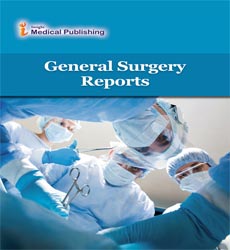Surgical Management of Complex Hernias: Techniques and Complications
*Corresponding author:
Cahaya Faiq,
Department of Biomedical, Metabolic and Neural Sciences, University of Modena and Reggio Emilia, 41125 Modena, Italy,
E-mail: Faiq.cahaya@unimore.it
Received date: February 03, 2025, Manuscript No. ipgsr-25-20674; Editor assigned date: February 05, 2025, PreQC No. ipgsr-25-20674 (PQ); Reviewed date: February 10, 2025, QC No. ipgsr-25-20674; Revised date: February 17, 2025, Manuscript No. ipgsr-25-20674 (R); Published date: February 24, 2025
Citation: Faiq C (2025) Surgical Management of Complex Hernias: Techniques and Complications. Gen Surg Rep Vol.09.1:173.
Introduction
Hernias represent a common surgical condition characterized by the protrusion of abdominal contents through a defect in the abdominal wall or diaphragm. While straightforward hernias, such as small inguinal or umbilical hernias, can often be managed with standard surgical techniques, complex hernias pose a significant clinical challenge. Complex hernias may involve large defects, recurrent hernias, multiple coexisting defects, loss of domain, or significant comorbidities, necessitating advanced surgical planning and intervention. These hernias are associated with higher risks of complications, recurrence, and postoperative morbidity, highlighting the importance of careful evaluation and individualized management strategies. The surgical management of complex hernias has evolved significantly over the past few decades. Traditional open approaches have been complemented by minimally invasive laparoscopic and robotic-assisted techniques, each offering specific advantages and limitations. Open surgery provides direct visualization and tactile feedback, facilitating repair of extensive defects and management of dense adhesions. Laparoscopic and robotic-assisted approaches offer reduced tissue trauma, improved visualization of the abdominal cavity, and faster postoperative recovery, though they require advanced technical skill and specialized equipment [1].
Description
The classification of complex hernias is multifactorial, encompassing recurrent hernias, large or giant defects, parastomal hernias, incisional hernias with loss of domain, and hernias in patients with significant comorbidities or prior failed repairs. Preoperative evaluation involves detailed imaging, such as Computed Tomography (CT) or Magnetic Resonance Imaging (MRI), to assess defect size, location, involvement of intra-abdominal organs, and the presence of adhesions. Imaging guides surgical planning, informs the choice of repair technique, and helps anticipate potential intraoperative challenges.
Open repair remains a cornerstone in the management of complex hernias, particularly in cases with extensive defects, dense adhesions, or multiple prior abdominal surgeries. Techniques such as component separation, mesh reinforcement, and flap reconstruction are commonly employed. Component separation involves mobilizing abdominal wall musculature to close large midline defects, restoring functional anatomy while minimizing tension. Mesh reinforcement, using synthetic or biologic materials, provides structural support and reduces the risk of recurrence. The choice between synthetic and biologic mesh depends on factors such as contamination risk, tissue quality, and patient comorbidities. Open repair allows direct visualization, tactile feedback, and precise control over defect closure, though it may be associated with increased postoperative pain, wound complications, and longer hospital stays.
Minimally invasive approaches, including laparoscopic and robotic-assisted hernia repair, have gained popularity in recent years. Laparoscopic repair involves small incisions, insufflation of the abdominal cavity, and placement of mesh under direct vision, often using a transabdominal preperitoneal or intraperitoneal onlay technique. Advantages include reduced tissue trauma, lower infection rates, shorter hospital stays, and faster recovery. Robotic-assisted repair enhances dexterity, precision, and visualization, particularly in complex or recurrent hernias, allowing meticulous dissection and intracorporeal suturing. Case studies highlight that robotic platforms are especially beneficial in patients with prior failed repairs or complex abdominal wall anatomy, where conventional laparoscopy may be technically challenging [2].
Despite advancements, surgical management of complex hernias carries a significant risk of complications. Common intraoperative complications include visceral injury, bleeding, and inadvertent enterotomy, particularly in patients with dense adhesions or prior abdominal surgeries. Postoperative complications may include wound infection, seroma formation, hematoma, mesh-related issues, chronic pain, and recurrence. Recurrence rates in complex hernias are higher than in primary hernias, emphasizing the importance of meticulous surgical technique, appropriate mesh selection, and tension-free repair.
Conclusion
The surgical management of complex hernias represents a significant challenge due to the size, location, and recurrence potential of these defects, as well as patient-specific factors such as comorbidities and prior surgical history. Open, laparoscopic, and robotic-assisted techniques each offer distinct advantages and limitations, with the choice of approach guided by anatomical considerations, patient characteristics, and surgeon expertise. Open surgery provides direct visualization and tactile feedback, making it ideal for extensive defects and dense adhesions, while minimally invasive approaches offer reduced tissue trauma, shorter recovery, and improved patient satisfaction. Complications, including wound infection, seroma, bleeding, visceral injury, chronic pain, and recurrence, remain a concern in complex hernia surgery.
Preventive strategies, including meticulous surgical technique, appropriate mesh selection, tension-free repair, and preoperative optimization of patient health, are critical to minimizing risk. Technological advancements, such as robotic-assisted platforms, advanced mesh materials, and enhanced imaging modalities, have expanded the scope and efficacy of minimally invasive approaches, improving both functional and aesthetic outcomes. Successful management of complex hernias requires individualized treatment planning, careful patient selection, multidisciplinary collaboration, and rigorous postoperative care. Through a combination of advanced surgical techniques, innovative technologies, and patient-centered strategies, surgeons can achieve optimal clinical outcomes, reduce complications, and enhance long-term quality of life for patients facing the challenges of complex hernia repair.
Acknowledgement
None.
Conflict of Interest
None.
Reference
- Gigot JF, Jadoul P, Que F, Van Beers BE, Etienne J, et al. (1997) Adult polycystic liver Is fenestration the most adequate operation for long-term management? Ann Surg 225: 286-294.
Google Scholar Cross Ref Indexed at
- Swenson K, Seu P, Kinkhabwala M, Maggard M, Martin P, et al. (1998) Liver transplantation for adult polycystic liver disease. Hepatology 28: 412-415.
Google Scholar Cross Ref Indexed at
Open Access Journals
- Aquaculture & Veterinary Science
- Chemistry & Chemical Sciences
- Clinical Sciences
- Engineering
- General Science
- Genetics & Molecular Biology
- Health Care & Nursing
- Immunology & Microbiology
- Materials Science
- Mathematics & Physics
- Medical Sciences
- Neurology & Psychiatry
- Oncology & Cancer Science
- Pharmaceutical Sciences
